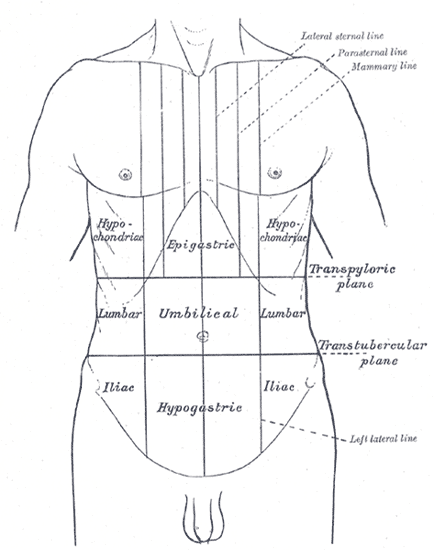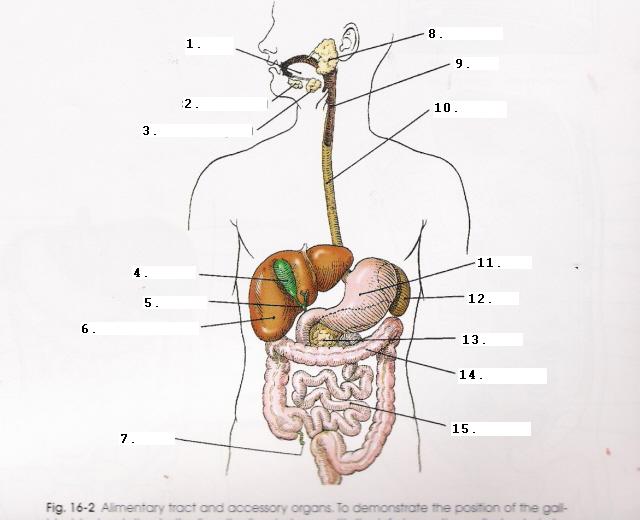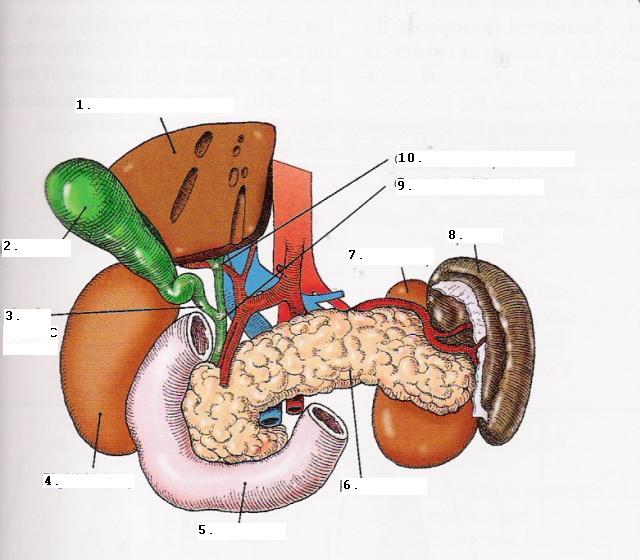Liver And Biliary System

OVER 10 QUESTIONS. HELPS TO BETTER UNDERSTAND WHERE TO TAKE X-RAY ACCORDING TO ANATOMY.
Questions and Answers
- 1.
WHAT IS THE LARGEST GLAND IN THE BODY?
Explanation
The liver is the largest gland in the body. It is responsible for various important functions such as detoxification, metabolism, and production of bile. It plays a crucial role in the digestion and absorption of nutrients, as well as the regulation of blood sugar levels. The liver also produces important proteins and enzymes that are necessary for proper bodily functions. Due to its size and numerous vital functions, the liver is considered the largest gland in the body.Rate this question:
- 2.
WHAT REGION(S) DOES THE LIVER OCCUPY MOST
Explanation
The correct answer is HYPOCHONDRIAC, EPIGASTRIC, RIGHT HYPOCHONDRIAC, EPIGASTRIC, HYPOCHONDRIUM, EPIGASTRIUM, RIGHT HYPOCHONDRIUM, EPIGASTRIUM, RIGHT HYPOCHONDRIUM. The liver occupies the hypochondriac region, the epigastric region, and the right hypochondriac region. It also occupies the hypochondrium, epigastric region, and the right hypochondrium. Therefore, the liver occupies multiple regions in the upper abdomen.Rate this question:
- 3.
WHAT CONVEYS BLOOD TO THE RIVER?
- A.
SPLEEN
- B.
PANCREAS
- C.
PORTAL VEIN
- D.
CYSTIC DUCT
Correct Answer
C. PORTAL VEINExplanation
The portal vein is responsible for conveying blood to the liver. It carries nutrient-rich blood from the digestive organs, such as the stomach, intestines, and spleen, to the liver for processing and detoxification. This vein plays a crucial role in maintaining the liver's function and overall health. The spleen, pancreas, and cystic duct do not have a direct role in conveying blood to the liver, making them incorrect options.Rate this question:
-
- 4.
WHAT'S MISSING?THE PORTAL SYSTEM CONSISTS OF THE PORTAL VEIN ON WALLS OF STOMACH, GALLBLADDER, PANCREAS, &_____________
Correct Answer
SPLEENExplanation
The correct answer is "spleen". The portal system consists of the portal vein, which is located on the walls of the stomach, gallbladder, pancreas, and spleen. The spleen plays a crucial role in the portal system as it filters blood, removes old or damaged red blood cells, and stores platelets. It is connected to the portal vein, allowing blood to flow from the spleen into the liver for further processing.Rate this question:
- 5.
WHAT IS THE PRIMARY CONSIDERATION OF THE PHYSIOLOGIC FUNCTIONS OF THE LIVER FROM A RADIOGRAPHIC VIEW?
- A.
FORMATION OF THE BILE
- B.
AMPULLA
- C.
SPLENIC VEIN
- D.
BUILDUP OF BLOOD
Correct Answer
A. FORMATION OF THE BILEExplanation
The primary consideration of the physiologic functions of the liver from a radiographic view is the formation of bile. Bile is produced by the liver and plays a crucial role in the digestion and absorption of fats. It helps in the emulsification of fats, making them easier to break down and absorb in the small intestine. A radiographic view can help evaluate the structure and function of the liver, including the formation and flow of bile, which is essential for proper digestion and metabolism.Rate this question:
-
- 6.
BILE IS THE CHANNEL FOR _______________________ FOR THE WASTE PRODUCTS OF ______ BLOOD ____ DESTRUCTION.
Correct Answer
ELIMINATION, RED, CELLExplanation
Bile is the channel for elimination of waste products of red blood cell destruction.Rate this question:
- 7.
THE BILE IS IMPORTANT AID IN EMULSIFICATION AND ASSIMILATION OF FATS, IS THIS AN ACT OF EXCRETION OR SECRETION?
- A.
SECRETION
- B.
EXCRETION
Correct Answer
A. SECRETIONExplanation
The given correct answer is "SECRETION." Bile plays a crucial role in the emulsification and assimilation of fats in the digestive system. It is produced by the liver and stored in the gallbladder before being released into the small intestine. This process of producing and releasing bile is known as secretion. Excretion, on the other hand, refers to the elimination of waste products from the body, which is not the case with bile. Therefore, the correct answer is secretion.Rate this question:
-
- 8.
TONGUESMALL INTESTINEAPPENDIXVISCERAL SURFACE OF LIVERSPLLENPANCREASPHARYNXPAROTID GLANDGALLBLADDERSUBMANDIBULAR GLANDLARGE INTESTINEBILIARY DUCTSESOPHAGUSLARGE INTESTINESUBLINGUAL GLAND
- 9.Correct Answer
1. TONGUE, 2. SUBLINGUAL GLAND, 3. SUBMANDIBULAR GLAND, 4. GALLBLADDER, 5. BILIARY DUCTS, 6. VISCERAL SURFACE OF LIVER, 7. APPENDIX, 8. PAROTID GLAND, 9. PHARYNX, 10. ESOPHAGUS, 11. STOMACH, 12. SPLEEN, 13. PANCREAS, 14. LARGE INTESTINE, 15. SMALL INTESTINE
1. TONGUE 2. SUBLINGUAL GLAND 3. SUBMANDIBULAR GLAND 4. GALLBLADDER 5. BILIARY DUCTS 6. VISCERAL SURFACE OF LIVER 7. APPENDIX 8. PAROTID GLAND 9. PHARYNX 10. ESOPHAGUS 11. STOMACH 12. SPLEEN 13. PANCREAS 14. LARGE INTESTINE 15. SMALL INTESTINE
TONGUE, SUBLINGUAL GLAND, SUBMANDIBULAR GLAND, GALLBLADDER, BILIARY DUCTS, VISCERAL SURFACE OF LIVER, APPENDIX, PAROTID GLAND, PHARYNX, ESOPHAGUS, STOMACH, SPLEEN, PANCREAS, LARGE INTESTINE, SMALL INTESTINE - 10.
PANCREAS, LEFT KIDNEYRIGHT KIDNEY, SPLEENCOMMON BILE DUCT, SYSTIC DUCTGALLBLADDER, COMMON HEPATIC DUCTCUT SURFACE OF LIVERDUODENUM
- 11.Correct Answer
1. CUT SURFACE OF LIVER, 2. GALLBLADDER, 3. CYSTIC DUCT, 4. RIGHT KIDNEY, 5. DUODENUM, 6. PANCREAS, 7. LEFT KIDNEY, 8. SPLEEN, 9. COMMON BILE DUCT, 10.COMMON HEPATIC DUCT
CUT SURFACE OF LIVER, GALLBLADDER, CYSTIC DUCT, RIGHT KIDNEY, DUODENUM, PANCREAS, LEFT KIDNEY, SPLEEN, COMMON BILE DUCT, COMMON HEPATIC DUCT
Quiz Review Timeline +
Our quizzes are rigorously reviewed, monitored and continuously updated by our expert board to maintain accuracy, relevance, and timeliness.
-
Current Version
-
Mar 22, 2023Quiz Edited by
ProProfs Editorial Team -
Oct 01, 2010Quiz Created by
Rufio




